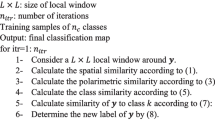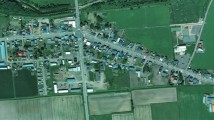Abstract
Three well-known feature extraction methods are modified for PolSAR image classification in this work. The polarimetric scattering characteristics of the PolSAR image containing randomness degree and scattering mechanism information are utilized to define a scattering coefficient. The defined coefficient is used to modify the principal component analysis (PCA), linear discriminant analysis (LDA) and locality preserving projection (LPP). The simple defined scattering coefficient, without any free parameter or any requirement to training samples, involves the scattering information into the PCA, LDA and LPP transforms. New projection models are developed according to the scattering coefficient. Finally, an edge preserving filter with the first principal component as the guidance image is suggested for importing the spatial characteristics and cleaning the speckle noise. The experimental results show superior performance of the modified feature extraction methods compared to the conventional methods and some state-of-the-art methods.






Similar content being viewed by others
Data availability
No new data is used in this paper. The datasets used for the experiments are benchmark datasets.
References
Xie W, Jiao L, Zhao J (2016) PolSAR image classification via D-KSVD and NSCT-domain features extraction. IEEE Geosci Remote Sens Lett 13(2):227–231
Ferguson JE, Gunn GE (2022) Polarimetric decomposition of microwave-band freshwater ice SAR data: Review, analysis, and future directions. Remote Sens Environ 280:113176
Abdeen MM, Gaber A, Shokr M, El-Saadawy OA (2018) Minimizing labeling ambiguity during classification process of the geological units covering the central part of the Suez Canal Corridor, Egypt using their radar scattering response. Egypt J Remote Sens Space Sci 21(1):S55–S66
Shi H, Zhao L, Yang J, Lopez-Sanchez JM, Zhao J, Sun W, Shi L, Li P (2021) Soil moisture retrieval over agricultural fields from L-band multi-incidence and multitemporal PolSAR observations using polarimetric decomposition techniques. Remote Sens Environ 261:112485
Horch A, Djemal K, Gafour A, Taleb N (2019) Supervised fusion approach of local features extracted from SAR images for detecting deforestation changes. IET Image Process 13(14):2866–2876
Mohammadian Fini R, Mahlouji M, Shahidinejad A (2022) Performance improvement in face recognition system using optimized Gabor filters. Multimed Tools Appl 81(27):38375–38408
Imani M, Ghassemian H (2019) Morphology-based structure-preserving projection for spectral–spatial feature extraction and classification of hyperspectral data. IET Image Process 13(2):270–279
Samat A, Li E, Du P, Liu S, Miao Z (2021) Improving deep forest via patch-based pooling, morphological profiling, and pseudo labeling for remote sensing image Classification. IEEE J Sel Topics Appl Earth Obs Remote Sens 14:9334–9349
Duan Y, Liu F, Jiao L (2016) Sketching model and higher order neighborhood markov random field-based SAR image segmentation. IEEE Geosci Remote Sens Lett 13(11):1686–1690
Zhang W-C, Wang Y-F, Hu G-H (2008) Compression of multi-polarimetric SAR intensity images based on 3D-matrix transform. IET Image Process 2(4):194–202
Liu F, Shi J, Jiao L, Liu H, Yang S, Wu J, Hao H, Yuan J (2016) Hierarchical semantic model and scattering mechanism based PolSAR image classification. Pattern Recognit 59:325–342
Mullissa AG, Persello C, Reiche J (2021) Despeckling polarimetric SAR data using a multistream complex-valued fully convolutional network. IEEE Geosci Remote Sens Lett, in press
Lin L, Li J, Shen H, Zhao L, Yuan Q, Li X (2022) Low-resolution fully polarimetric SAR and high-resolution single-polarization SAR image fusion network. IEEE Trans Geosci Remote Sens 60:1–17 (Art no. 5216117)
Wu Q, Hou B, Wen Z, Ren Z, Ren B, Jiao L (2020) Structure label matrix completion for PolSAR image classification. Remote Sens 12(3):459
Xiao D, Liu C, Wang Q, Wang C, Zhang X (2020) PolSAR image classification based on dilated convolution and pixel-refining parallel mapping network in the Complex Domain, arXiv:1909.10783v2
Shao Q, Yu L, Guo Y, Xie X, Zou J, Li L (2023) Weakly supervised semantic segmentation of PolSAR image based on improved SEAM. J Phys: Conf Ser 2456:012003
Tian T, Gao L, Song W et al (2018) Feature extraction and classification of VHR images with attribute profiles and convolutional neural networks. Multimed Tools Appl 77:18637–18656
Zhang L, Chen Z, Zou B, Gao Y (2018) Polarimetric SAR Terrain classification using 3D convolutional neural network. Int. Geosci. Remote Sens. Symp. (IGARSS), Valencia, Spain, pp 4551–4554
Liu Q, Lang L (2021) Multi-manifold feature fusion based neural networks for target recognition in complex-valued SAR imagery. ISPRS J Photogramm Remote Sens 180:151–162
Zhang L, Jiao L, Ma W, Duan Y, Zhang D (2019) PolSAR image classification based on multi-scale stacked sparse autoencoder. Neurocomputing 351:167–179
Hua W, Zhang Y, Zhang C, Jin X (2023) PolSAR image classification based on relation network with SWANet. Remote Sens 15(8):2025
Ma Y, Li Y, Zhu L (2019) Land cover classification for polarimetric SAR Image using convolutional neural network and superpixel. Progress Electromagn Res B 83:111–128
Ahishali M, Kiranyaz S, Ince T, Gabbouj M (2021) Classification of polarimetric SAR images using compact convolutional neural networks. GISci Remote Sens 58(1):28–47
Zhang L, Dong H, Zou B (2019) Efficiently utilizing complex-valued PolSAR image data via a multi-task deep learning framework. arXiv:1903.09917v2
Zhu Y, Zhang X, Hu R, Wen G (2018) Adaptive structure learning for low-rank supervised feature selection. Pattern Recognit Lett 109:89–96
Imani M, Ghassemian H (2014) Principal component discriminant analysis for feature extraction and classification of hyperspectral images. 12th Iranian Conference on Intelligent Systems, Bam, Iran, 4–6 Feb
Wang C, Wu P (2021) Image classification based on principal component analysis optimized generative adversarial networks. Multimed Tools Appl 80:9687–9701
Dalmiya CP, Santhi N, Sathyabama B (2019) A novel feature descriptor for automatic change detection in remote sensing images. Egypt J Remote Sens Space Sci 22(2):183–192
Imani M, Ghassemian H (2015) Feature space discriminant analysis for hyperspectral data feature reduction. ISPRS J Photogramm Remote Sens 102:1–13
Liu M, Chen S, Wu J, Lu F, Wang J, Yang T (2018) Configuration recognition via class-dependent structure preserving projections with application to targets in SAR images. IEEE J Sel Topics Appl Earth Obs Remote Sens 11(6):2134–2146
Imani M, Ghassemian H (2015) Feature extraction using weighted training samples. IEEE Geosci Remote Sens Lett 12(7):1387–1391
Liu Y, Jiang B, Feng J et al (2021) Classification of EEG signals for epileptic seizures using feature dimension reduction algorithm based on LPP. Multimed Tools Appl 80:30261–30282
Hu R, Zhu X, Cheng D, He W, Yan Y, Song J, Zhang S (2017) Graph self-representation method for unsupervised feature selection. Neurocomputing 220:130–137
Park S, Moon WM (2007) Unsupervised classification of scattering mechanisms in polarimetric SAR data using fuzzy logic in entropy and alpha plane. IEEE Trans Geosci Remote Sens 45(8):2652–2664
Zhao J, Datcu M, Zhang Z, Xiong H, Yu W (2019) Contrastive-regulated CNN in the complex domain: a method to learn physical scattering signatures from flexible PolSAR images. IEEE Trans Geosci Remote Sens 57(12):10116–10135
Kuo BC, Landgrebe DA (2004) Nonparametric weighted feature extraction for classification. IEEE Trans Geosci Remote Sens 42(5):1096–1105
Gadhiya T, Roy AK (2020) Superpixel-driven optimized wishart network for fast PolSAR image classification using global k -means algorithm. IEEE Trans Geosci Remote Sens 58(1):97–109
Imani M (2021) Patches based edge preserving network for land cover classification using polarimetric synthetic aperture radar images. Int J Remote Sens 42(13):4946–4964
Zhang Z, Wang H, Xu F, Jin Y (2017) Complex-valued convolutional neural network and its application in polarimetric SAR image classification. IEEE Trans Geosci Remote Sens 55(12):7177–7188
Nie X, Ding S, Huang X, Qiao H, Zhang B, Jiang Z (2019) An online multiview learning algorithm for PolSAR data real-time classification. IEEE J Sel Topics Appl Earth Obs Remote Sens 12(1):302–320
Cohen J (1960) A coefficient of agreement from nominal scales. Edu Psychol Meas 20(1):37–46
Author information
Authors and Affiliations
Corresponding author
Ethics declarations
Conflict of interest
The author declares that she has no conflict of interest.
Additional information
Publisher’s Note
Springer Nature remains neutral with regard to jurisdictional claims in published maps and institutional affiliations.
Rights and permissions
Springer Nature or its licensor (e.g. a society or other partner) holds exclusive rights to this article under a publishing agreement with the author(s) or other rightsholder(s); author self-archiving of the accepted manuscript version of this article is solely governed by the terms of such publishing agreement and applicable law.
About this article
Cite this article
Imani, M. Modified PCA, LDA and LPP feature extraction methods for PolSAR image classification. Multimed Tools Appl 83, 41171–41192 (2024). https://doi.org/10.1007/s11042-023-17269-7
Received:
Revised:
Accepted:
Published:
Issue Date:
DOI: https://doi.org/10.1007/s11042-023-17269-7




